Wearing Masks to Slow COVID-19 Spread and Prevent Sepsis
June 9, 2020
Since the start of the COVID-19 pandemic, there have been many debates about if members of the public should wear face masks. Initially, the World Health Organization (WHO) and health services in many countries said that wearing masks outside of a hospital setting wasn’t necessary. The reasoning was that unless you wore an N95 mask, one that prevents 95% of airborne particles passing through, masks would not protect you from becoming ill.
Opinion Changing on Masks
Despite the initial opinion, many people worried if they should be wearing masks anyway. They pointed to some countries, such as Japan, where masks are not unusual in public. It’s considered to be polite and responsible to wear the masks – not to protect themselves, but to protect others from illness such as a cold.
Now, as scientists still work on learning more about the novel coronavirus that causes COVID-19, the WHO and the U.S. Centers for Disease Control and Prevention (CDC), have recommended that people should wear non-medical masks when they are in situations where keeping a distance of 6 feet or 2 meters apart isn’t possible.
Infection Prevention
Sepsis Alliance encourages people to do what they can to help to stop the spread of any type of infection, whether it is through vaccinations, proper care of wounds, and infection prevention tools like wearing masks whenever needed. Sepsis is the number one complication related to COVID-19, so every case that is prevented is another case of sepsis prevented.
Different Types of Masks
There are different types of masks. Each mask plays a different role and is used in specific circumstances:
N95 respirators: These special masks are either domed or shaped like a duck bill. A special filter attaches to the mask to filter out 95% of airborne particles. Front-line healthcare workers who have a chance of being exposed to “aerosoled” virus particles use this mask. For example, if a doctor inserts an endotracheal (ET) tube into a patient to place her on a ventilator, or a respiratory technologist administers an aerosol treatment, they are exposed to infected droplets in the air.
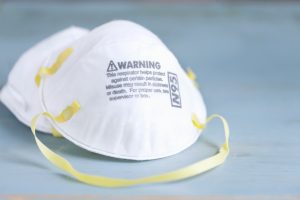
Surgical/medical masks: These are the masks you are most familiar with, the kind you’re handed if you need a disposable one. Healthcare personnel also wear these when they are doing certain types of procedures, including surgery, so they can prevent passing germs to the patient.

Non-medical masks: These are cloth masks made for people who don’t work in the healthcare environment and don’t require the higher level of protection offered by the other masks. Cloth masks, whether homemade or purchased are not meant to protect the wearer from contracting the infection. They are meant to prevent the wearer from sharing germs if they are infected. They are a physical barrier from particles spreading from you, especially if you sneeze or cough. According to the WHO, up to 80% of COVID-19 infections cause only mild symptoms or even no symptoms (asymptomatic). Therefore, it’s best to assume that you may be contagious even though you may feel perfectly fine.
Masks Are Only One Part of Protective Measures
Wearing a mask is only part of the safety campaign aimed at reducing the spread of COVID-19. It is an add-on to all the other things we must do. And, for a mask to be effective, it must be used and handled correctly, or else the infection will spread anyway.
The CDC now recommends that the public wear masks when in a place where there cannot be a 6-foot distance from others. The social or physical distancing is more effective, but there are situations – such as taking public transit or grocery shopping – where this isn’t possible.
Hand washing is still very important if you wear a mask. You should wash your hands before putting one on and after taking it off. Do not touch your mask once it is on. As you breathe, your breath moistens the fabric. As you touch the fabric, any germs from you that are on the mask can be passed to your fingers. Then you touch something like a bus pole and leave the germ behind for someone else to touch.
Except in situations where you must remove your mask, like eating or drinking, don’t reuse your mask before cleaning it. It’s best to have at least two masks, if not more, so you can switch them out. Wash one and wear one.
Best Homemade Masks
There have been many debates and some studies as to what the best fabrics are for cloth masks. Most places recommend two layers of high quality quilting cotton, with perhaps a pocket into which you can put a filter. However, it is another debate as to whether a filter is needed or not. Since the mask is not to keep you from contracting the virus, many people believe the filter isn’t necessary. And for some, the filter may make it a bit tougher for them to breathe. The tight weave of the fabric is the key to helping keep particles from passing through as much as possible. Many mask makers are using two layers of high quality, tightly woven cotton. The most recent recommendation from the WHO is to have three layers:
- Inner layer of absorbent fabric, most often 100% cotton
- Middle layer of a non-woven fabric, and they give polypropylene as an example
- Outer layer of a polyester or polyester blend
The potential drawback to a thicker mask is people may find it more uncomfortable, especially in the hot summer weather.
Style
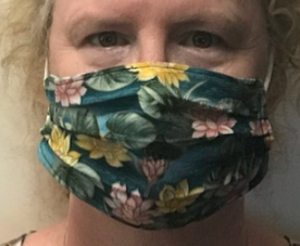
 The style of mask you wear is a personal choice. Some people prefer the pleated rectangular masks, while others prefer the fuller, cupped versions. The important thing is that it is as comfortable for you as possible and that it fits. A mistake many people make is wearing a mask that is too big. They feel it’s more comfortable as it is roomier. But if you look at a too-big mask, you will see a lot of gaps along the sides, bottom, and top. The mask should feel snug.
The style of mask you wear is a personal choice. Some people prefer the pleated rectangular masks, while others prefer the fuller, cupped versions. The important thing is that it is as comfortable for you as possible and that it fits. A mistake many people make is wearing a mask that is too big. They feel it’s more comfortable as it is roomier. But if you look at a too-big mask, you will see a lot of gaps along the sides, bottom, and top. The mask should feel snug.
Whichever style you choose, it’s vital that you wear the mask properly. Too many people are seen with the mask over their mouth and under their nose. Some only on the chin. Unless both the nose and mouth are sufficiently covered, the mask is useless.
Nose wire or no nose wire?
Some cloth masks have a nose wire, similar to the surgical masks. People are making these with floral wire, twist ties, even chenille wires or what used to be called pipe cleaners. This is a personal preference. They are helpful in reducing fogging if you wear glasses.
Elastics or ties?
Again, this is personal preference. Elastics are easier to put on and take off, especially for people who may have limited mobility in their arms. But elastics can also make your ears hurt. You can get around this by using ear savers, which could be a plastic piece at the back of your head that you can hook the elastics on or a headband with buttons. Another alternative is to tie a ribbon or strip of fabric to each of the elastics and loop that over your head.
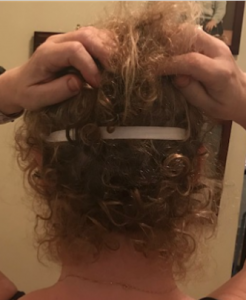
Because everyone is different, it can be hard to find a well-fitting mask so there are some work arounds. If the elastics are too tight, using the ribbon around the back of the head is a good solution. If the elastics are too loose, you can flip the elastics (pass the upper part under the ear and the lower part over the ear) so they fit more securely.
Some people find ties more comfortable because they feel they can fit them better. The one drawback is they are more time consuming to put on and take off, but they may last a bit longer than the elastic.
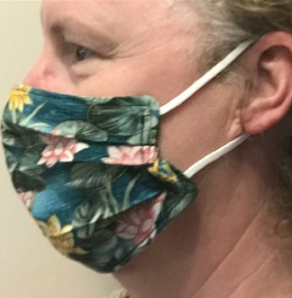
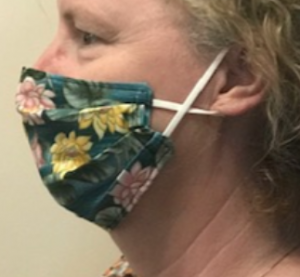
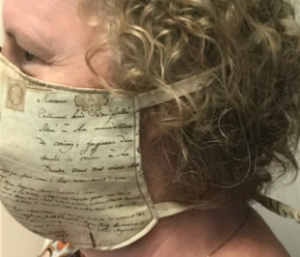
Caring For Your Mask
When you take off your mask, do not touch the mask itself. If it has loops, hook a finger under one loop and lift it off your face. Only handle the loops/elastics. If you have ties, untie the bottom ties first, then the top ones, keeping hold of one as it becomes loose. Handle it with that tie. Wash your hands well after you’ve handled the mask.
If you have a filter in your mask, take hold of it by the edge and throw it away. Wash your hands well after handling it.
Masks should be washed in hot water separate from other laundry. You can keep using the masks until they start to show too much signs of wear. If you need to reuse the mask later in the day, perhaps you need to eat lunch, for example, when you take the mask off, make sure to fold it outside touching and place it in a clean paper bag until you can use it again. Wash your hands again. When it is time to reuse the mask, take it out of the bag by the loops or ties – avoiding touching the mask itself as much as possible. If your mask has ties, fasten the top ones first, and then the bottom ones. And, of course, wash your hands once you’re done.
To learn more about COVID-19, please visit the Sepsis Alliance COVID-19 Resource Page.





























